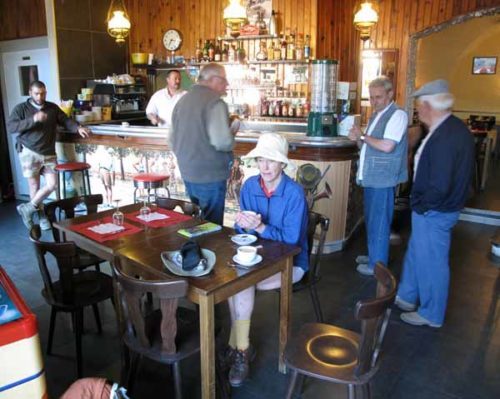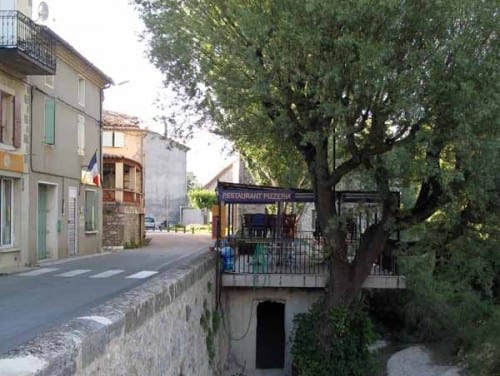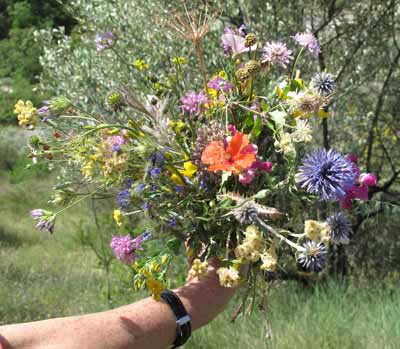
Sunday, 24 June 2012
Distance 20 km
Duration 4 hours 15 minutes
Ascent 364 m, descent 380 m
Map 164 of the TOP 100 lime-green series
The last Sunday in June is a big day in Sainte-Jalle, the day of the vide-grenier, a big street market under the trees in the road outside the camping ground. We had seen stalls being set up the evening before and there was a general bustle from behind the hedge when we woke at 5:30.
In the hope of a functioning coffee stall by the time the market opened at 7, we lay in bed until 6 and had a dawdling bowl of muesli at the same table that we had used for dinner. The apricots from the épicerie made it a bit less plain than usual.

On the stroke of 7, we stepped out into the shady avenue.
The good citizens of the village had been through their attics and found grandma’s furniture, just the thing for selling at the vide-grenier, but it seemed that everybody’s grandma had had the same taste and there was an awful lot of dark, shiny, spindly stuff on display.
There were also a couple of side-show amusements and, of more interest to us, a stall selling hot drinks.

We bought two tiny black coffees (€1 each) and took them to a sunny bench against a wall, as the air was still cold in the shade. With the addition of the last of our powdered milk they were excellent.

When we got to the main road at the end of the avenue, we were astonished to see the bar open, contrary to the épicerie woman’s assurance that it would be closed all weekend.

It was the second time that we had been misled by the locals of this village and there was no doubt a lesson in it.
Anyway, we were pleased, and, having invested in some pastries from the boulangerie, we went inside and had a second breakfast.

Then I made a mistake in reading the map and we took a little tour of the back streets, picturesque but not very helpful.
Back at the bar, we set off again, this time along the main road, and just around the bend we came to a restaurant which nobody had mentioned.
It was called Les Lavandes and had an attractive terrace cantilevered out over the stream.

At this hour it was not open, but it probably had been last night when we had been reduced to a scratch meal in the camping ground. Another lesson, or perhaps the same one – ask and keep asking, look and keep looking.

Shortly after this, guided by GRP marks, we turned left over a bridge and immediately right along a side-stream. We were on a small tar road which we followed for an hour without seeing a car.

Then it turned sharply up from the river flats towards the perched village of Rochebrune with its slant-topped tower and fine church.
At this point the GRP set off up the scrubby hillside in the direction of the ridge crest, but we decided not to go that way.
Keith was feeling the after effects of the bad cold that had laid him low for three weeks before we departed, and the less strenuous route seemed to be along the little road that climbed gently and gradually to the Col d’Ey.
This part of the road was almost as deserted as the first, except for an occasional farm vehicle.
We were now passing through orchards of apricot and cherry, as well as vineyards, and from the road we could look across to Sainte-Jalle in the valley, with le Poët-Sigallat and the mountains of yesterday behind.

The cherries had been harvested but there were a couple of trees beside the road that still carried a crop, so we filled our hats with the shiny, succulent fruit, and swung along spitting pips for the next little while.


At the Col d’Ey the road joined another one and suddenly became busier, but we were pleased that we had no more climbing to do.
We sat on a stone beside the intersection, to rest and have a swig of water. A grand new view had opened up to the south, where the road twisted down among pines to the valley of Buis-les-Baronnies.
All along the skyline crouched the massive recumbent shape of Mont Ventoux, bare and bleached on top as if covered with snow. It had originally been forested, but over-harvesting of the timber, starting in the twelfth century, had stripped off the soil and revealed the underlying limestone.

As we descended on the road, we met numbers of gasping cyclists on their way up. Evidently we were now on a popular cycle route, although none of the riders seemed to be enjoying themselves.
Even going down, Keith felt the weariness of his recent illness and walked slowly, so I amused myself by collecting a posy of wildflowers from beside the road, which involved a bit of scrambling up and down the bank. Cars came past but infrequently.
Having made a long sweep across the face of the range, our road switched back and kept descending.

We could now see Buis-les-Baronnies with the saw-toothed spine of the Rocher de Saint-Julien above it, and we hoped that our route tomorrow would not take us that high.
Passing an olive grove where the trees looked as ancient as the stones that they grew in, we soon joined the main road along the valley of the Ouvèze and for the last three kilometres we walked beside traffic, although in the outskirts of the town there was a footpath which made our progress pleasanter.
We came to a supermarket that was still open (it was nearly midday) and went in to get a baguette, but forgot to get powdered milk, so that later, when settled at one of the bars in the centre, Keith had to rush back for it before closing time.

Buis-les-Baronnies had the air of a spa town, without the wheelchairs and walking frames. There were people promenading along the river front, and the main square near the bridge was full of enticing-looking restaurants and bars.
At one of these we took our third round of coffee for the day, which was a much better record than yesterday.
The municipal camping ground, one of three in the town, was advantageously placed just over the bridge and as soon as we arrived we sank down exhausted, too tired even to have showers at first. We were under a large linden tree, whose flowers snowed lightly down on us so that we felt like Mahler’s broken-hearted wayfarer. We found out later that linden trees are a speciality of the town.

Lunch, when we finally had it after refreshingly hot showers, was grander than normal because of the remains of last night’s picnic dinner.
The camembert was molten and strongly aromatic after its hot journey, but on fresh bread, washed down with wine, it was delicious, and we finished with a handful of cherries.
Attached to the camping ground was the municipal pool, where we went to pay our dues. It looked cool and inviting but we were too tired to have a swim. Sleeping seemed a better idea.
Later in the afternoon we were invited to a nearby caravan for a cup of tea. The occupants were English and must have heard us speaking. Tea and conversation flowed freely.
We sat on a bench in the shade, but they preferred the full scorching sun – “We pay money for this!”, they said.

When we walked back to town in the evening it was still 31°C, but we felt fresh in our sandals and clean clothes.
The place was crowded with summer visitors and we got the last outdoor table at the restaurant on the corner, after our glasses of cold rosé next door.

For €17 each we got a three-course meal. Keith began with a salad of chèvre chaud (crumbed, fried goat’s cheese on a salad) and I had “bouche de la reine” – pastry filled with seafood.
Next we both had steak with an array of lovely vegetables, not including chips, and to finish, Keith had tiramasu, while I negotiated a coffee instead of dessert.
It was wonderfully nourishing and delightful, but by the time we got up to leave we were tired again and went straight to bed as soon as we got back to the tent.
Previous day: Rémuzat to Ste-Jalle